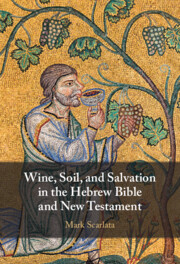81 results
Thomas Cranmer’s Appropriation of the Eucharistic Theology of Cyril of Alexandria: The Construction and Defence of a Reformed Agenda
-
- Journal:
- Journal of Anglican Studies , First View
- Published online by Cambridge University Press:
- 10 March 2025, pp. 1-15
-
- Article
- Export citation

Wine, Soil, and Salvation in the Hebrew Bible and New Testament
-
- Published online:
- 09 January 2025
- Print publication:
- 23 January 2025
14 - The Body of Jesus in His People
- from Part III - Ethics, Theology, and Critical Scholarship
-
-
- Book:
- The New Cambridge Companion to Jesus
- Published online:
- 15 November 2024
- Print publication:
- 05 December 2024, pp 232-249
-
- Chapter
- Export citation
Chapter 4 - Realist Liturgies
-
- Book:
- Liturgy, Ritual, and Secularization in Nineteenth-Century British Literature
- Published online:
- 14 November 2024
- Print publication:
- 21 November 2024, pp 100-126
-
- Chapter
- Export citation
Chapter 5 - Liturgical Aestheticism
-
- Book:
- Liturgy, Ritual, and Secularization in Nineteenth-Century British Literature
- Published online:
- 14 November 2024
- Print publication:
- 21 November 2024, pp 127-147
-
- Chapter
- Export citation
Epilogue
-
- Book:
- Liturgy, Ritual, and Secularization in Nineteenth-Century British Literature
- Published online:
- 14 November 2024
- Print publication:
- 21 November 2024, pp 165-170
-
- Chapter
- Export citation
Introduction
-
- Book:
- Theology and the Mythic Sensibility
- Published online:
- 07 November 2024
- Print publication:
- 21 November 2024, pp 1-12
-
- Chapter
- Export citation
Chapter 6 - Against Immanence
-
- Book:
- Liturgy, Ritual, and Secularization in Nineteenth-Century British Literature
- Published online:
- 14 November 2024
- Print publication:
- 21 November 2024, pp 148-164
-
- Chapter
- Export citation
5 - Finding an Ending
-
- Book:
- The Theological Imagination
- Published online:
- 09 November 2024
- Print publication:
- 07 November 2024, pp 127-160
-
- Chapter
- Export citation
3 - Bearing Ambiguity
-
- Book:
- The Theological Imagination
- Published online:
- 09 November 2024
- Print publication:
- 07 November 2024, pp 67-104
-
- Chapter
- Export citation
Intercession and Anamnesis in the Eucharist
-
- Journal:
- Journal of Anglican Studies , First View
- Published online by Cambridge University Press:
- 27 March 2024, pp. 1-15
-
- Article
-
- You have access
- Open access
- HTML
- Export citation
It is Good for Us to Be Here: Joseph Ratzinger’s Christocentric Doctrine of Creation in Response to Anti-Natalism
-
- Journal:
- New Blackfriars / Volume 105 / Issue 4 / July 2024
- Published online by Cambridge University Press:
- 06 March 2024, pp. 352-369
- Print publication:
- July 2024
-
- Article
-
- You have access
- Open access
- HTML
- Export citation
Lauda Sion as Doxological Compendium of St. Thomas’s Eucharistic Theology
-
- Journal:
- New Blackfriars / Volume 105 / Issue 2 / March 2024
- Published online by Cambridge University Press:
- 06 February 2024, pp. 105-115
- Print publication:
- March 2024
-
- Article
-
- You have access
- HTML
- Export citation
II.40 - A Woman Is Tried for Heresy at Norwich: a Court Record
- from Fifteenth Century
-
- Book:
- The Cambridge Anthology of British Medieval Latin
- Published online:
- 11 January 2024
- Print publication:
- 01 February 2024, pp 352-356
-
- Chapter
- Export citation

The Cambridge Companion to Joseph Ratzinger
-
- Published online:
- 25 January 2024
- Print publication:
- 21 December 2023
Chapter 5 - Orders for the Stational Mass in Frankish Cities and Monasteries
- from Part II - The Arrangement of Rites
-
- Book:
- Roman Liturgy and Frankish Creativity
- Published online:
- 04 January 2024
- Print publication:
- 18 January 2024, pp 103-139
-
- Chapter
- Export citation
10 - A Resurrected Body
- from Part III - The Body of Christ
-
- Book:
- An Augustinian Christology
- Published online:
- 02 November 2023
- Print publication:
- 16 November 2023, pp 342-377
-
- Chapter
- Export citation

An Augustinian Christology
- Completing Christ
-
- Published online:
- 02 November 2023
- Print publication:
- 16 November 2023
10 - Sacrificial Knowing: Cyprian and Early Christian Ritual Knowledge
-
-
- Book:
- The Intellectual World of Late Antique Christianity
- Published online:
- 05 October 2023
- Print publication:
- 26 October 2023, pp 166-184
-
- Chapter
- Export citation


